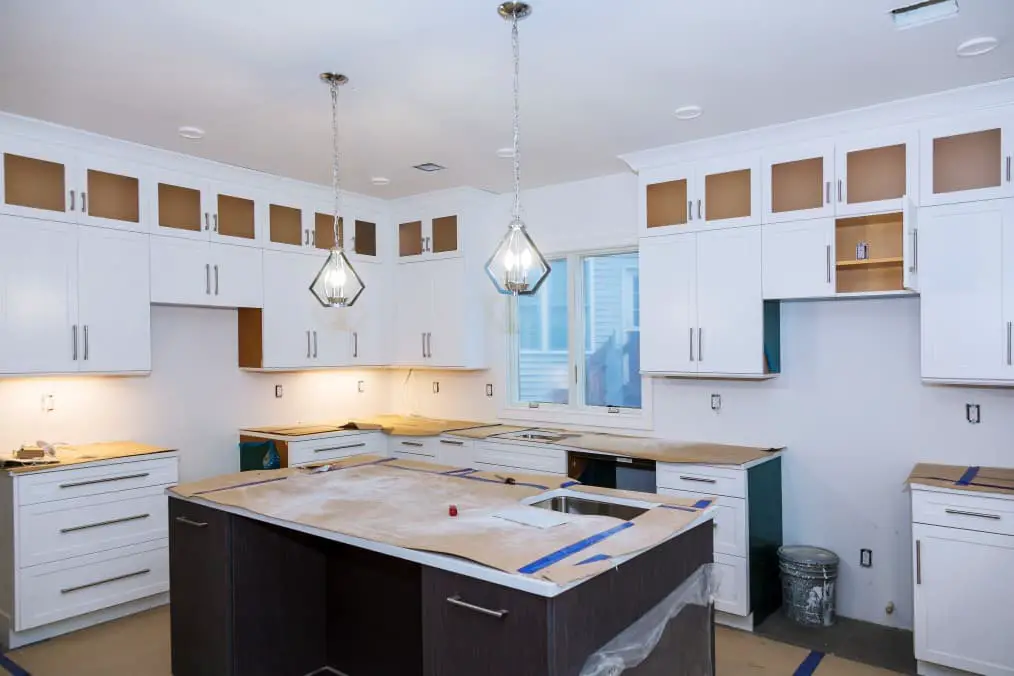Knowing the kitchen cabinet installation process is a must for every homeowner looking to renovate their kitchen. But since this can be a complex task, let’s break down the step-by-step process to make it digestible.

Required Preparation Kitchen Cabinet Installation
Aside from the cost of purchasing new kitchen cabinets, the installation part is another major concern that you must address.
Especially if you’re on a budget, equipping yourself with this skill will help you save a lot of money. Hiring a pro for the task means paying for the labor charge, going from a few hundred dollars to thousands.
For this case, it’s crucial to learn the kitchen cabinets installation process. An important tip for this is to have a helping hand who can help you with lifting and reaching.
Like other home improvement projects, the preparation part of kitchen cabinets installation is also very crucial.
Here are the steps you need to take:
-
Removing Existing Cabinetry and Appliances
If there are existing cabinets and appliances in the kitchen, the first step is to remove them. It will help remove all obstructions once you’re ready for the kitchen cabinets installation. Make sure to turn off water supply lines, electrical lines, and gas.
Of course, you’ll have to remove all existing cabinet doors and drawers as well as huge appliances. It also involves removing the countertop, molding, sink, and toe kicks from the existing cabinet. Then, unscrew the face frames and the cabinet’s back from the wall to completely pull them out.
-
Preparing the Space
You then have to inspect the walls and all the corners of the kitchen to ensure they’re flat and square. You can do this by using a level, straight 2×4, and a framing square.
After the inspection, make sure to mark any bumps, bubbles, and uneven angles that require alterations. Later on, repair these areas by patching and smoothing. You can also apply coats of paint to the wall area to further elevate a fresh and flawless look. Check the same issues with the flooring where you will install new cabinets and do the necessary repairs.
Also, make sure to install the electrical lines before the kitchen cabinets installation. It will save you time and hassle later on from designating them in unstrategic areas. Furthermore, make sure to rough in-wall switches, cabinet lines, and supply lines.
-
Marking the Reference and Layout Line
Next, it will be helpful to create a measurement plan for your kitchen cabinets installation. For this task, it will help to mark reference and layout lines on the wall surface as a guide. Measure everything from the walls, windows, and door.
With a level, try to keep the line around 48 inches starting from the floor.
Here’s how you can measure the following for the kitchen cabinets installation:
- Floor’s high point: Where the measurement is shortest from the floor
- Base cabinet height: Beneath the floor high point’s mark or 34 inches above
- Top of base cabinet: Draw out a level layout line from the mark of the base cabinet height
- Upper cabinet’s bottom edge: 17 to 18 inches from base cabinet’s layout line
Once you locate the studs, mark their respective locations on the layout lines you made. You can try drilling a small hole in these locations to prepare for the kitchen cabinets installation. It’s also vital to mark the locations where appliances will go.
How to Install Different Types of Kitchen Cabinets
Depending on the area of kitchen cabinet installation, the step-by-step procedure will also vary. Hence, it’s vital to determine which step is for which to ensure a smooth installation process.
Corner Base Cabinet
- Lift the corner cabinet into place. Shim it from the floor until the cabinet’s back edge reaches the layout line.
- Push the cabinet against plumbline lines and then mark the area on the cabinet’s back panel.
- Turn around the cabinet and start drilling through the back position.
- Using the level, check if the cabinet face is in a straight and balanced position.
- Bolt a 4 and ½ inch deck screws through the cabinet’s back, top, and bottom as well as the studs
- If the cabinet is not plumb, place shims between the wall and the cabinet’s back or the floor and the cabinet’s bottom. Once you fix its position, start bolting the screws through the shims and studs.
- Using a deck screw, fasten the cabinet onto the floor.
Base Cabinets
- After the corner cabinet installation, insert shims from the wall studs and from the floor. It will ensure that the frames are balanced and level with the existing layout line.
- Make sure to align the cabinets flush with the corner cabinets. After clamping the cabinets together, utilize a counterbore through the frames’ edge and then fasten using 2-inch screws.
- Bolt the shimmed deck screws through the back of the cabinet into the studs.
- To close the gap between the cabinet and the wall, scribe the back edge or stile. You can also do this by trimming.
- Remove any protruding shims beyond the cabinet edges with a utility knife. Also, remove the support cleats for the wall cabinet and use spackle to fill the holes.
- Put the shelves and drawers in their designated cabinets.
Upper Cabinets
- Lift the upper cabinet up into the cleat. If you don’t have a cabinet jack in place, make sure that you ask for help from a friend or a family member.
- Using the level, check if the cabinet face is in a straight and balanced position. Upon ensuring this, bolt a 4 and ½ inch deck screws through the back, top, and bottom of the cabinet. Bolt the screws as well through the studs.
- If the cabinet is not plumb, insert shims between the studs and the wall and the back of the cabinet. Once you fix its position, start bolting the screws through the shims and studs.
- For the remaining cabinets, lift them onto the cleat and then clamp and screw their edges.
- To close the gap between the end cabinet and the wall, scribe the back edge or tile. You can also do this by trimming.
Tips on Kitchen Cabinet Installation
Before we end this guide, it will be helpful for you to learn some smart kitchen cabinet installation tips. It helps you prepare all the required tools and prevent any possible mistakes as you proceed with the project.
Furthermore, it will provide you with a clear idea of the things you must note and remember along with the project.
With that, here are some kitchen cabinet installation tips that will help guide you along the way:
Before the Installation
- Planning is the most important among all kitchen cabinet installation tips. It involves everything from marking reference and layout lines, studs, determining electrical lines, etc.
- Make sure to identify the top of the base cabinet from the floor’s high point.
- Determine the exact measurements of appliances and sinks before proceeding with the installation or modifying cabinet openings.
- To prevent wood splitting, make sure to pre-drill wood-to-wood screwing beforehand.
- Apply soap or paraffin wax on the screw surface to prevent snapping off.
- Make sure to clean the kitchen area thoroughly. It’s not only for an obstruction-free workspace but also to ensure safety.
- You can use a stud finder to mark every cabinet stud location.
- Don’t forget to mark all electrical lines, plumbing lines, piping, and other elements that you don’t mean to screw into.
- Mark the name of each cabinet on the wall space it will occupy to avoid confusion.
Installation
- One of the best kitchen cabinet installation tips is to start with the base and tall cabinets first. It allows you to create a template for your counters and also provides extra workspace when installing wall cabinets.
- Always start with the corner cabinets going towards the ends.
- Make sure to remove drawer and door fronts to prepare for clamping the cabinets together.
- Measure twice before marking and drilling for plumbing lines in sink cabinets.
- Utilize shims throughout the installation process to ensure the level of the cabinet frame.
- Make sure that the position of your wall cabinets is in line with a comfortable and natural door swing for you.
- As you’re installing the cabinets, check from time to time if the base and wall cabinets are centered on each other.
Installing Kitchen Cabinets Like a Pro
Kitchen cabinet installation is a major part of any kitchen renovation project. As such, it is vital to know the steps required in the process to ensure a seamless project flow.
The key lies in paying close attention to detail and doing comprehensive research prior.
While it is convenient to hire a pro, you can save a lot of money by doing it yourself.
We hope this guide provided you with all the information you need in installing kitchen cabinets!
